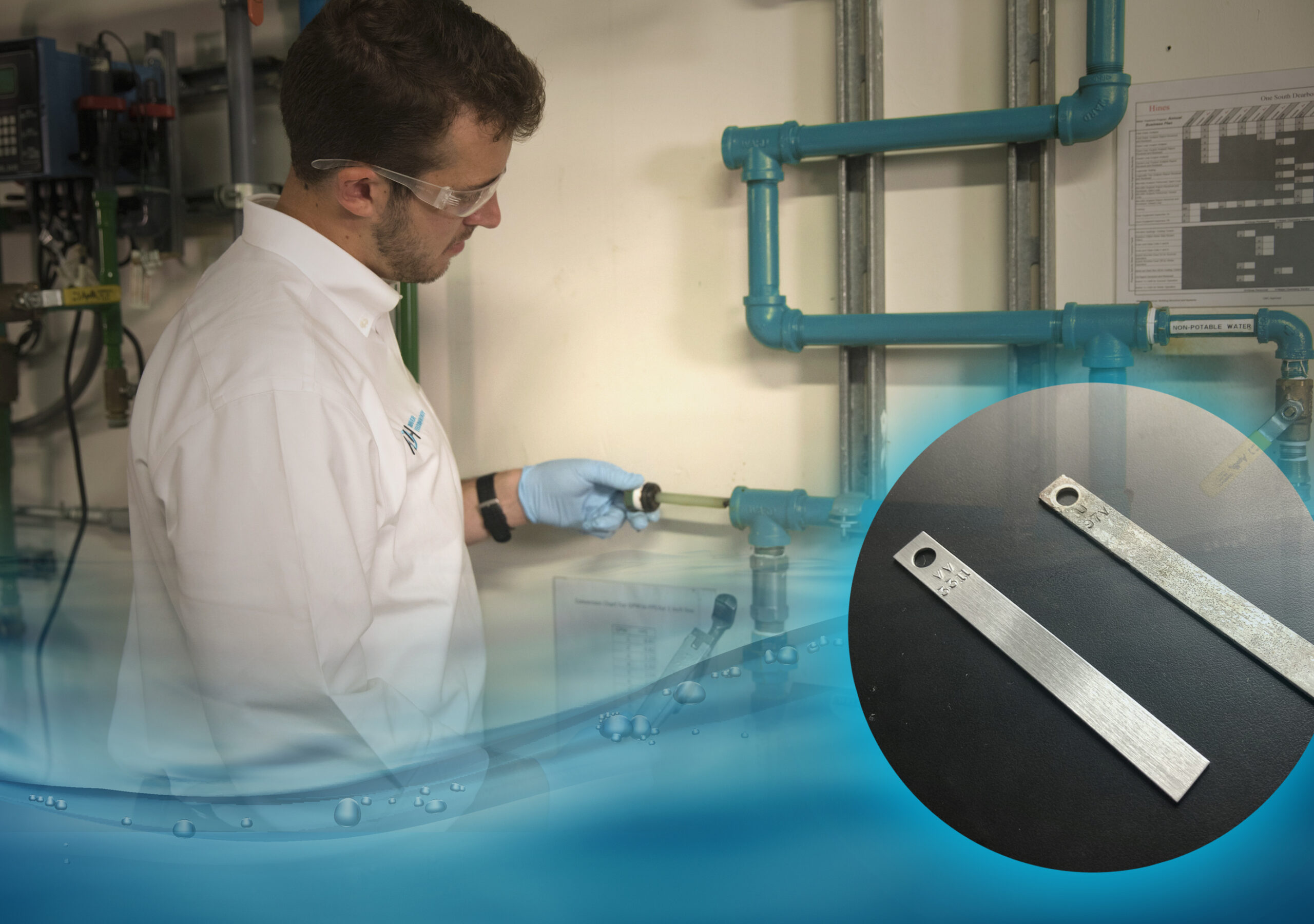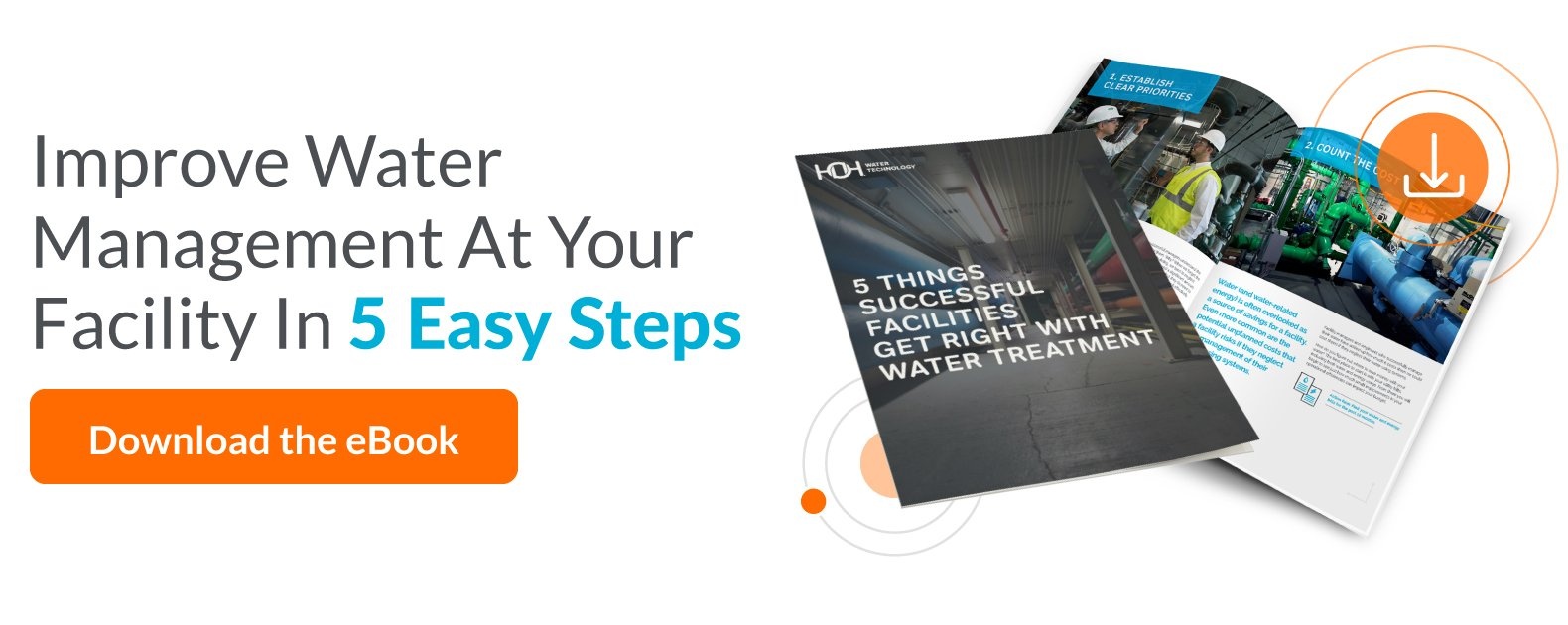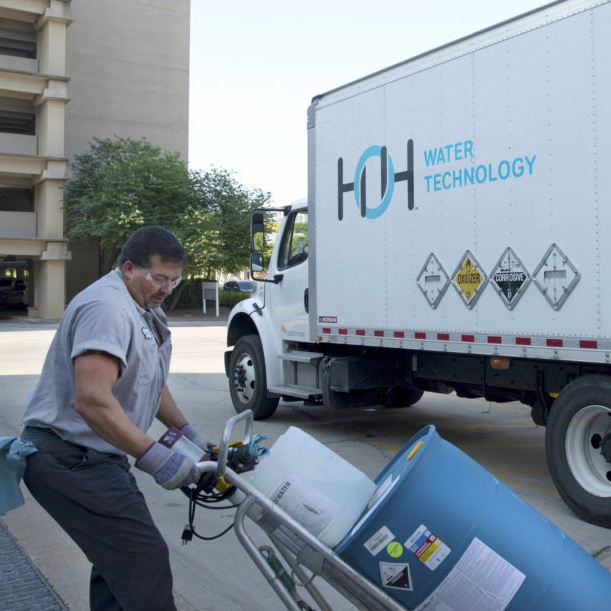
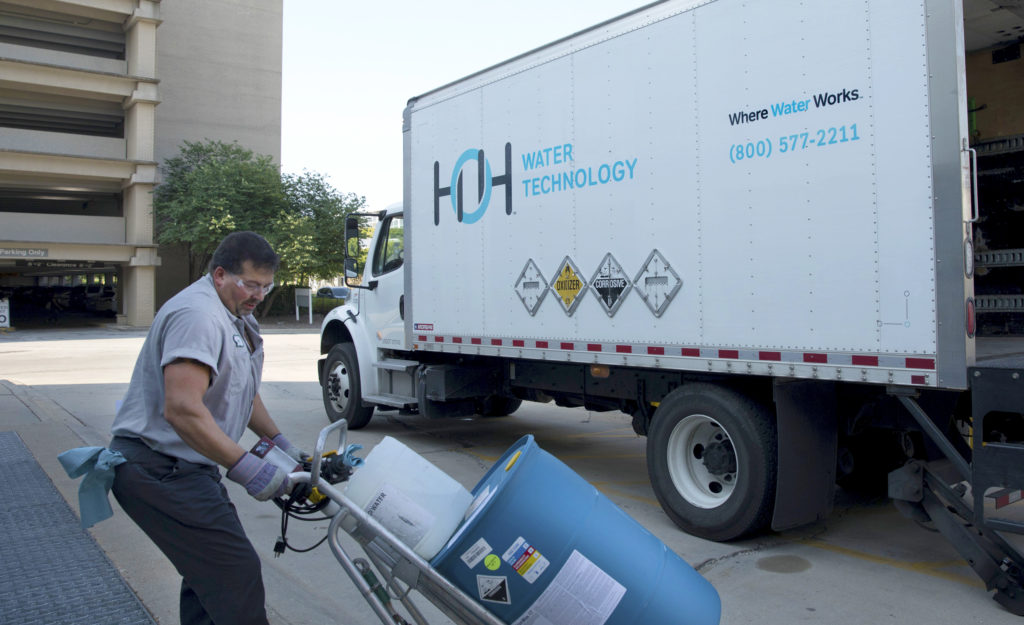 Many facilities handle chemical treatment without the expertise and support of a water treatment partner. This puts a tremendous amount of responsibility on building managers and facility teams to receive, store, dispense and manage water systems chemicals safely. Under normal circumstances, this is difficult work. But what happens when something goes wrong, such as a spill? Do you have a prevention plan? Will you know how to respond in an emergency? Read on to learn best practices for safe handling of water systems chemicals.
Many facilities handle chemical treatment without the expertise and support of a water treatment partner. This puts a tremendous amount of responsibility on building managers and facility teams to receive, store, dispense and manage water systems chemicals safely. Under normal circumstances, this is difficult work. But what happens when something goes wrong, such as a spill? Do you have a prevention plan? Will you know how to respond in an emergency? Read on to learn best practices for safe handling of water systems chemicals.
Delivery Models For Chemical Treatment Programs
Most facilities fall into one of the following models for receiving and dispensing industrial water chemical treatments:
1) Receiving Dock Drop-Off
The vendor drops off the chemicals at a receiving dock and the facility then moves the chemicals to the point-of-use and dispenses them for treatment.
2) Point-of-Use Drop-Off
The chemicals are delivered by the vendor directly to the point-of-use (a boiler room for example) and then the facility dispenses the water systems chemicals.
3) Bulk Delivery & Dispense
A vendor delivers the chemicals to the point-of-use and dispenses them for treatment.
Models 1 & 2 pose a substantial risk for the facility. As Dean Miller, Materials Director for HOH points out, there’s a lot to know and a lot can go wrong quickly:
“Knowing how to blend chemicals properly is not common knowledge, even for an experienced facility team. Few know the danger levels associated with handling their own chemicals.“
Miller has seen first-hand what can go wrong.
“We were recently called out to a facility where a customer had to evacuate 200 people and shut down business for a day because an employee poured a chlorine-based product into a tank with an acid-based product already in it. The reaction formed chlorine gas, which forced the facility to be evacuated and endure weeks of remediation. In the end, it was an extremely dangerous and costly situation.”
Professional water treaters know which chemicals “play nicely together” and which do not. They also understand the many government and industry regulations for chemical handling.
As Miller points out, “The frontline worker in the boiler room should not be expected to know the ins and outs of government regulations. It’s helpful to have a water treatment partner to navigate compliance.”
Government regulations from different agencies can be unclear and verbose and sometimes conflict with each other. For example, the Department of Transportation regulations and the EPA guidelines can be quite different, which confuses facility managers.
“Different agencies have different regulations for hazardous materials storage and handling. Add industry-specific regulations like those found in the healthcare or food-handling industries and you have levels of compliance and complexity that are too much for most building managers to handle alone.”
Water Treatment Chemicals & Their Risks
Some chemicals can be corrosive to equipment and must be carefully dispensed to avoid causing irreparable damage. Most treatment chemicals are also harmful to humans when they come into contact with skin or eyes or are inhaled. In worst-case scenarios, they can cause bodily harm (such as temporary skin or lung irritation as well as chronic health problems), or even death.
Dangerous reactions can occur when certain chemicals come into contact with each other. They can cause explosions or hazardous leaks that create environmental damage well beyond your facility.
Miller advises: “Never mix oxidizers with corrosives or acids with chlorines. Keep these chemicals apart.”
OSHA provides guidance on safe distances for most common chemical combinations.
We recommend that facility managers and staff have at least a working knowledge of these commonly-used industrial water treatment chemicals:
- Chlorine (gas)
- Sodium hypochlorite
- Calcium hypochlorite
- Aluminum sulfate
- Soda ash
- Sodium bicarbonate
- Ferric chloride
- Sodium bisulfite
- Sodium hydroxide
- Sulfuric Acid
- Hydrofluoric acid
- Sodium hydroxide
- Various polymer solutions for coagulation and flocculation
Remember, the name on the drum label will probably be a product brand created by the manufacturer and not the actual name of the chemical. You’ll have to look further down on the label under “Hazardous Chemicals” to find out what exactly is in the blend.
When There’s a Chemical Spill
Hopefully, this will never be a problem for your facility, but it’s best to be prepared.
“It happens,” says Miller, “Unfortunately, not every facility is equipped to handle a spill and not every employee knows what to do. Sometimes even when there’s a protocol in place, people panic and start trying to clean it up right away. They grab mops and towels and forget about personal protective gear like gloves and goggles.”
We recommend having an emergency response plan and proper training for spill response. Part of that training should cover the importance of protective gear and protocol for what to do first. All facilities and maintenance employees should receive this training.
“Engineers sometimes just want to get in there and fix something when it breaks. They’ll run to fix the problem before throwing on a respirator. In the heat of the moment, people will put themselves in harm’s way.”
If a dangerous spill occurs, calling your local fire department immediately and evacuating employees is your best course of action.
Best Practices For Handling Water Systems Chemicals
Whether you’re handling your own chemical program or working with a trusted partner, your team can benefit from following these best practices for chemical handling.
Using Your Safety Data Sheets
Safety data sheets list all information relating to occupational safety and health for the use of various chemicals. They are mandated by OSHA. Train your people on how to read SDS documentation and keep the sheets close to the drum or on your tanks.
Establishing a Facility Safety Team and Plan
You should also form a safety team to be proactive about proper chemical handling at your facility. This team can take the lead on establishing safety and hazardous cleanup protocols and focus on having the right training and supplies.
Posting Emergency Phone Numbers
Your safety team needs to look up emergency phone numbers for local first responders. You should post these numbers in visible areas and keep them regularly updated.
Stocking Personal Protective Equipment (PPE)
Keep PPE such as respirators, gloves, face shields, glasses over the face shields and aprons in good condition and easily accessible. Make sure everyone on your facilities team knows how to use the equipment properly.
Mistakes To Avoid
Some of the most common chemical handling mistakes are easily corrected. See if you are guilty of any of these oversights.
Not Properly Labeling Your Drums
This could mean something as simple as not having your tanks clearly marked or labeled. It leaves open the possibility that the wrong chemical could be dispensed to that tank, creating hazardous conditions.
Not Checking Your Fittings/Hook-Ups
Your water systems chemicals may be stored and labeled properly, but if the tanks are not outfitted with the proper hose hook-ups, you’re asking for a spill. You need proper fittings and hook-ups on all tanks to ensure that the hose is locked down and nothing will spray outside of the tank.
Doing What Has Always Been Done
Don’t accept what has always been done. If your facility has not taken a look at water safety protocols in a while, or if you see a potential problem, speak up. Don’t assume you’re following best practices just because “it’s always been done this way.”
When to Call An Industrial Water Treatment Partner
Miller advises that it might be time to call a water treatment partner when:
“The danger, manpower or cost exceeds what you think you can handle on your own. This is especially true if the size or complexity of your industrial water systems requires you to have frequent or labor-intensive water testing.”
It’s not reasonable to expect your average facility engineer to be responsible for staying up-to-date on the latest regulatory guidelines and manage all of the dangers involved in chemical handling and dispensing.
“Our people are used to handling the chemicals and know what to do if something unfortunate were to happen,” says Miller.
There’s also a cost advantage to calling a water treater. HOH, for example, does regular testing and monitoring of our clients’ water systems so that we can head off an expensive problem before it happens.
Says Miller, “If you’re taking a DIY approach, you may be causing damage to your water systems and not know it until it’s too late. But the real cost is when you’ve caused bodily harm or long-term health problems for your employees. We can help you avoid that.”
Recent Blog Posts
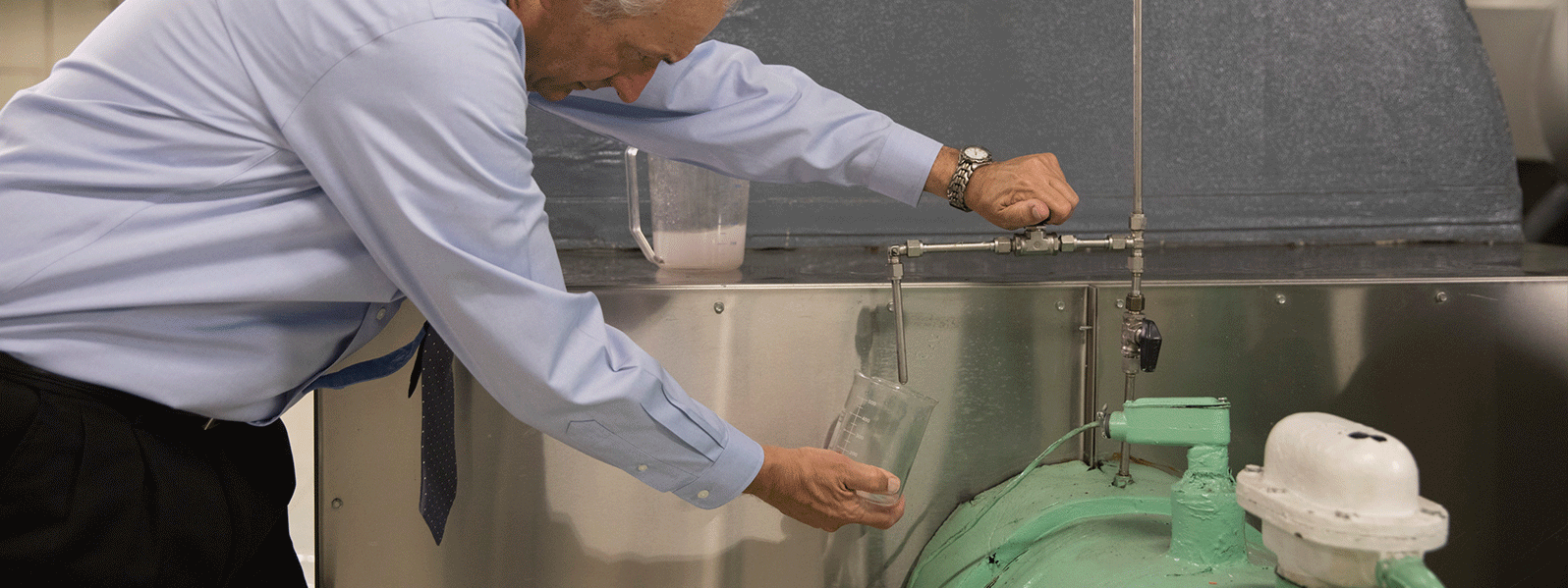
Five Ways to Increase the Efficiency of Your Closed Loop System

Global 6K for Water
